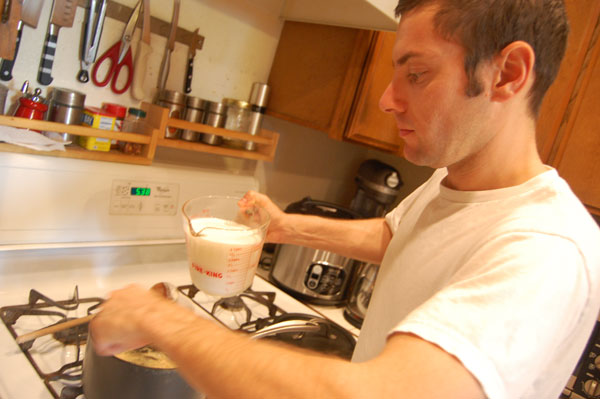
Last week I showed you how to make a roux, which is basically flour cooked in fat, and in doing so we laid the foundation for greater things.
Roux isn’t for eating by itself, of course, but is used to thicken such things as sauces and gravies, which themselves are used in a supporting role to build a main dish.
One easy sauce to build from a roux is béchamel, also known as white sauce. Don’t worry: It tastes better than its rather bland name. In fact, in classical French cooking, this sauce is so important that it’s known as a “mother sauce.” It’s called that because from it even more elaborate sauces can be made.
Béchamel is a thick, milk-based sauce. It gets its thickness from the roux, which also helps give the sauce a nutty, hearty flavor.
Some béchamel recipes call for cooking onions with the roux for added flavor, but you can leave them out if you’re not hot on onions, are short on time, or want a smoother sauce without the need for straining. Other than the roux and the milk, about the only other things this sauce needs are a couple of bay leaves and a dash of nutmeg. And some time, but not a whole lot.
At around half an hour, it doesn’t take long to make. Béchamel can be used in lasagna, other dishes calling for a white sauce, or as a less-fattening basis for Alfredo sauce, which traditionally calls for heavy cream and butter.
When I make béchamel, I use it as a foundation for a spectacular cheddar cheese sauce, for which I could almost eat by itself.
I’ll show you how to do that next week. For now, here’s how to build a béchamel from a roux.
BASIC BECHAMEL FROM ROUX
- 32 ounces (a quart) of whole milk
- 1/4 teaspoon nutmeg
- 2 bay leaves
Step 1: Now that you’ve made the roux, slowly pour in a third of the milk and whisk continually until smooth. Let the milk come to a simmer, add another third of the milk and whisk and repeat until all the milk is in the pot.
Step 2: Bring the milk a boil very briefly, then turn the heat to low. Add the bay leaves and nutmeg, and simmer uncovered for 20-30 minutes or until the sauce has the thickness to your liking. Be sure to whisk often, plus scrape the bottom and sides of the pan, where the sauce has a tendency to stick.
Congratulations: You just made a béchamel sauce. From here, you can remove the bay leaves and use it in or on another dish, or as a basis for another sauce like a cheddar one, which we’ll get to next week.
Source: iwanttocook.com (defunct blog)































